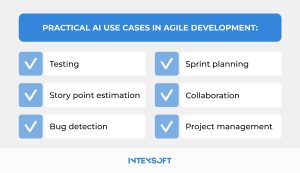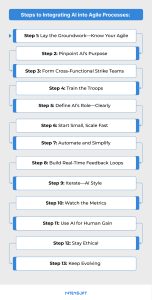
This article lays out what’s really happening as AI moves into the Agile process. From real-world use cases to a step-by-step breakdown, you’ll see how the AI software development life cycle is being reshaped, rethought, and retooled. And if you need to go deeper and make this work inside your own systems—we’re here. Reach out.
Reading time: 12 min.
Software teams had spent decades locked into rigid, bureaucratic processes—plans that looked solid on paper but collapsed under real-world conditions. Deadlines slipped. Products launched are incomplete or outdated. Something had to change.
Agile is a methodology that has changed a mindset. It discarded the old top-down model, replacing it with something fluid—adaptive, iterative, built on collaboration rather than control. Teams would no longer wait for a perfect plan. They would build, test, and refine in real-time. The goal was speed and precision. Software had to meet the true needs of users, not the assumptions of executives.
The principles came from the Agile Manifesto, a document drafted in 2001 by a group of software developers. But the movement took on a life of its own. Companies of all sizes—tech startups, Fortune 500 firms, government agencies—began reshaping how they built software.
The shift was about framework and a broader transformation. Scrum became dominant, but it was just one path. Kanban, Lean, Extreme Programming (XP), and Feature-Driven Development (FDD)—each offered a variation on the same core idea: adaptability over rigidity, collaboration over hierarchy.
Look closely, and the pattern is unmistakable. Agile was a restructuring of how software was conceived, built, and delivered. The project-based mindset of the past was giving way to a product-focused future.
Now, artificial intelligence (AI) is pushing Agile to its next evolution.
In the Software Development Life Cycle (SDLC), AI forecasts project timelines, writes and refactors code, tests applications, and even flags security vulnerabilities before they become a problem. GitHub Copilot, ChatGPT, and Tabnine accelerate development at every stage.
Consider the workflow. A developer writes a function, and AI suggests the next lines of code before they type them. Bugs that once required hours of debugging are caught in seconds. Security loopholes that might have slipped through testing are flagged instantly. Even the final deployment process is shifting, as AI-driven automation tools ensure smoother, faster rollouts with minimal human intervention.
But this isn’t a replacement. It’s augmentation. The fear that AI will render developers obsolete is unfounded—at least for now. Instead, AI is handling the monotonous, repetitive tasks that slow down development. The real work, the creative and strategic thinking, remains firmly in human hands.
Nowhere is AI’s impact more profound than in cybersecurity. Machine learning algorithms actively predict threats, analyze network anomalies, and identify breaches in real-time. Defensive measures are automated, and countermeasures are deployed before exploits become public knowledge. In an offensive role, AI is just as powerful, reverse-engineering vulnerabilities and simulating attacks to strengthen security before real threats emerge.
AI agility is making processes faster—it’s making it smarter. Testing cycles that once took months can now be compressed into weeks if not days. AI-driven project management is reducing inefficiencies, integrating seamlessly with tools like GitHub Copilot to suggest pivots in project scope, reallocate resources, and even preempt delays.

Firstly, testing. Historically, a painstaking, manual process, now AI-driven tools like Testim are stepping in to construct automated test cases straight from user stories and requirements. The result is faster, more reliable testing. Human oversight shifts from creation to refinement.
AI is also imposing order on what has long been an inexact science: story point estimation. Platforms like Azure DevOps dig into historical project data, analyzing past trends to provide teams with story point estimates that are based on real patterns rather than best guesses.
Then, bug detection. No longer just a matter of catching errors after the fact. AI-powered systems like Microsoft’s IntelliCode are scanning code repositories, issue trackers, and previous versions, pinpointing vulnerabilities long before they can be exploited. It’s proactive rather than reactive.
Sprint planning, another staple of Agile, is also under AI’s watch. Jira’s Advanced Roadmaps harness performance metrics, team workload data, and project timelines to recommend the most efficient sprint plans. The goal is to optimize schedules and prevent overcommitment, burnout, and the kind of last-minute scrambling.
Even collaboration is no longer what it once was. AI is making it seamless, especially for remote and distributed teams. With real-time translations, automatic meeting summaries, and smart task assignments, tools like Slack are closing the communication gaps that once slowed progress. It’s an entirely new way of working.
Project management has evolved too. AI-powered analytics tools like Smartsheet are shifting teams from crisis response to risk anticipation. Instead of reacting to problems after they spiral, managers now see the warning signs early. Such an approach allows them to intervene before small issues turn into major setbacks.
Let’s look at our step-by-step guide on Agile AI, rooted in reality, for businesses serious about reshaping how they operate in 2025.

Before AI can reshape your sprint cycles, your team must speak agile fluently. Principles. Iterative development. Rapid feedback. Team collaboration. This is the true foundation. Without it, AI becomes just another disconnected system that is useless in execution.
Don’t integrate AI just because everyone else is. Investigate. Where are your bottlenecks? Which tasks drain your talent? Examine operations line-by-line. Repetitive tasks? Tedious data parsing? That’s where AI starts. In the context of the AI SDLC, the goal isn’t to replace human insight—it’s to remove friction and free people up to solve real problems.
Break silos. Bring together AI architects, agile developers, project leads, and domain experts. This isn’t about departmental turf wars—it’s war-room collaboration. The best breakthroughs happen when machine learning engineers and agile teams co-design the sprint playbook.
If your team doesn’t understand AI, it won’t matter how good your model is. Build AI literacy. Not just what it is, but how to use it—and where it could go wrong. The best AI strategies in 2025 start with training. You wouldn’t hand a weapon to someone untrained. The same applies here.
Assign tasks. Define what AI handles—data triage, trend analysis, predictive modeling—and what stays human. Codify performance standards, success metrics, and ethical guidelines.
Think pilot. Test AI in one part of the process—a marketing analysis sprint, a customer service workflow. Measure results, adjust, iterate. Only when you’ve proven value should you expand. Phased integration ensures you don’t lose the forest for the algorithm.
Use AI to eliminate the unnecessary. Streamline workflows. Cut the 32-step process down to 11. Then ask: What should we stop doing entirely?
Build feedback loops into every cycle. AI must learn constantly. Train it on live data. Use retrospectives to evaluate not just team performance, but AI performance. Let the data speak.
Agile is about iterations. So is AI. Use each sprint to retrain models, refine algorithms, and test outputs. Small changes, measured gains. This isn’t a one-shot deal. It’s a continuous calibration of man and machine.
Don’t trust the tech blindly. Track impact. Measure ROI. Monitor system behavior. Watch for drift. Without accountability, AI can veer off course. Numbers don’t lie. But you have to look.
The smartest play in 2025? Using AI to personalize. Marketing, customer experience, and even internal communication—when AI helps you speak to the right person with the right message at the right time, you win. But don’t chase personalization for its own sake. Make it count.
There’s power in AI. But unchecked, it’s dangerous. Build ethical frameworks into your process. Define what AI shouldn’t do. Bias, misuse, overreach—these are real threats. Put your values into the code. And remember: that last 20%—the magic—is still human.
The work isn’t done. Monitor. Learn. Adapt. Technology doesn’t wait, and neither can you. Integrate feedback. Foster experimentation. Encourage people to challenge assumptions.
The numbers don’t lie—32% of organizations now report that AI is accelerating the front end of development. Not just shaving time here and there, but moving from whiteboard sketches to working prototypes at a pace that wasn’t possible five years ago. It’s what’s happening on the ground.
Inside the AI development life cycle, timelines are tighter, decision points come faster, and the margin for error shrinks. Teams are building smarter. They’re navigating complexity with tools that offer direction, not just data. Dead ends are fewer. MVPs arrive earlier.
The companies paying attention are building momentum and finding clarity in the chaos. If you’re trying to understand how your business fits into this—how to move with it instead of against it—there’s help.